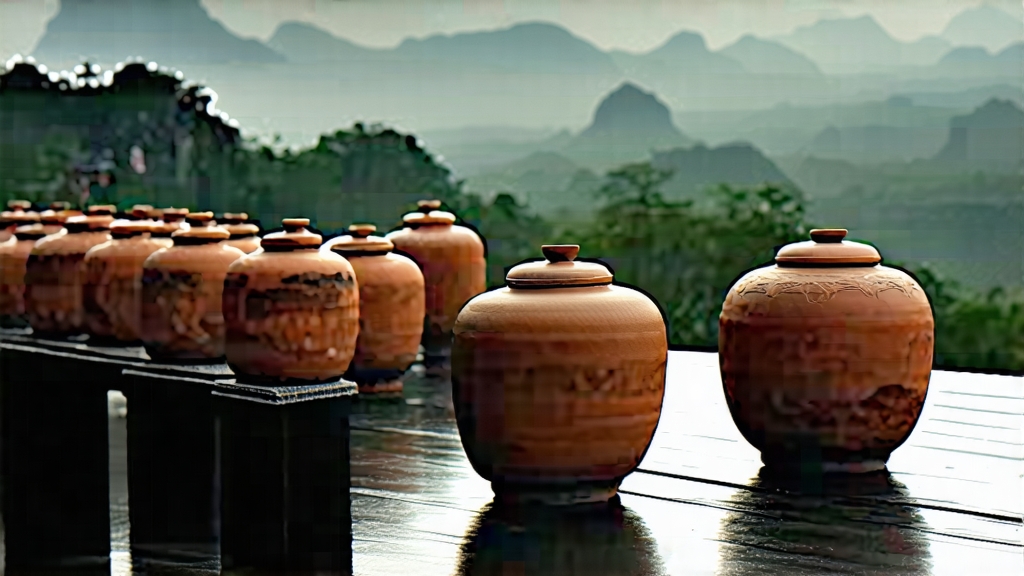
Tucked away in the humid, karst-pocked mountains of southern China’s Guangxi Zhuang Autonomous Region lies a tea that once traveled farther than silk: Liu Bao. To the uninitiated it is merely another dark brick, but to the people of the Pearl River Delta, Hong Kong tea houses, and the once-booming “Coolie Trade” of the nineteenth century, Liu Bao was liquid currency—an edible passport that could calm seasick stomachs, cut through greasy dim-sum, and age like the finest Bordeaux. Today, as global palates pivot toward depth, umami, and microbial complexity, Liu Bao is quietly stepping out of the shadow of Pu-erh to claim its own chapter in the epic of fermented tea.
Historical footprints
The earliest written record appears in the 1585 edition of the Cangwu County Annals, noting that “dark tea from Liu Bao” was bartered for salt and ironware. By the Qing dynasty (1644-1912) the Qing court had codified Liu Bao as one of the “Famous Teas for Tribute,” dispatching pressed baskets northward along the Xun River to the imperial granaries. When the British East India Company began transshipping Chinese laborers to Malayan tin mines in the 1850s, ship surgeons observed that migrants who drank Liu Bao suffered less dysentery; the tea became part of the standard rations, and its reputation for digestive protection spread across Southeast Asia. In 1950s Hong Kong, Liu Bao bricks were stacked in the back rooms of traditional medicine shops, sold not by gram but by slice—thin shavings shaved off with a cleaver, wrapped in newspaper, and prescribed for “damp stomach.” Thus, long before the word “probiotic” entered the wellness lexicon, Liu Bao was already a working-class remedy.
Terroir and leaf
Liu Bao is not a brand but a township—Liu Bao Zhen—nestled at 23°N among evergreen foothills where the Dayao Mountains funnel warm monsoon air into a perpetual mist. The native cultivar is the medium-leaf “Guangxi Daye” (Camellia sinensis var. sinensis), prized for its thick cuticle and high ratio of stem to blade; the stems act as conduits for later microbial colonization. Elevations of 300–800 m deliver cool nights that slow growth, concentrating catechins and soluble sugars. The soil is lateritic, rich in iron and potassium, imparting a subtle metallic snap that connoisseurs liken to the tang of blood orange peel. Crucially, the region is laced with cinnamon and camphor trees whose roots intermingle with the tea bushes; volatiles from these companion plants drift onto leaf surfaces, pre-flavoring the raw material before human hands ever touch it.
From basket to brick: the craft
Unlike Pu-erh, Liu Bao undergoes a uniquely Guangxi process called “wet-pile fermentation” (hou fa jiao) that predates the famous Yunnan technique by at least a century. The choreography begins in late April, when two leaves and a bud are plucked at dawn, wilted for two hours, then wok-fired at 280 °C for exactly four minutes to kill green enzymes. While still warm, the leaves are rolled into tight cords and piled 70 cm deep inside bamboo steamers. Here comes the twist: workers sprinkle mountain spring water (pH 6.2) onto the pile until moisture reaches 38 %, then cover it with jute sacks and banana leaves. Over the next 18–22 hours the core temperature climbs to 55 °C, activating thermophilic microbes—primarily Bacillus subtilis and Aspergillus niger—that oxidize polyphenols into theaflavins and thearubigins. The pile is turned every four hours to prevent anaerobic souring; when the leaf edges turn chestnut-brown and emit a scent reminiscent of damp betel nut, the tea is deemed “ripe.” After sun-drying on bamboo trays for three days, the semi-fermented leaf is packed into cylindrical bamboo baskets (long tong) lined with wild rattan. These baskets are stacked in riverside caves where relative humidity hovers at 85 % and temperature swings gently between 18 °C and 24 °C year-round. Inside the cave the tea continues a slow, secondary fermentation for anywhere from three to fifty years